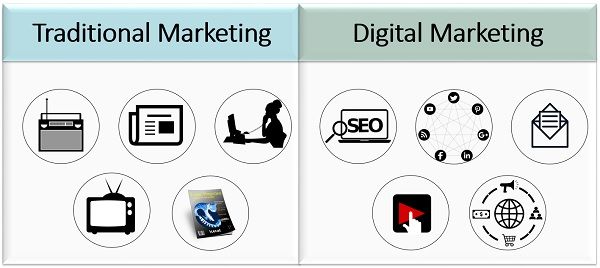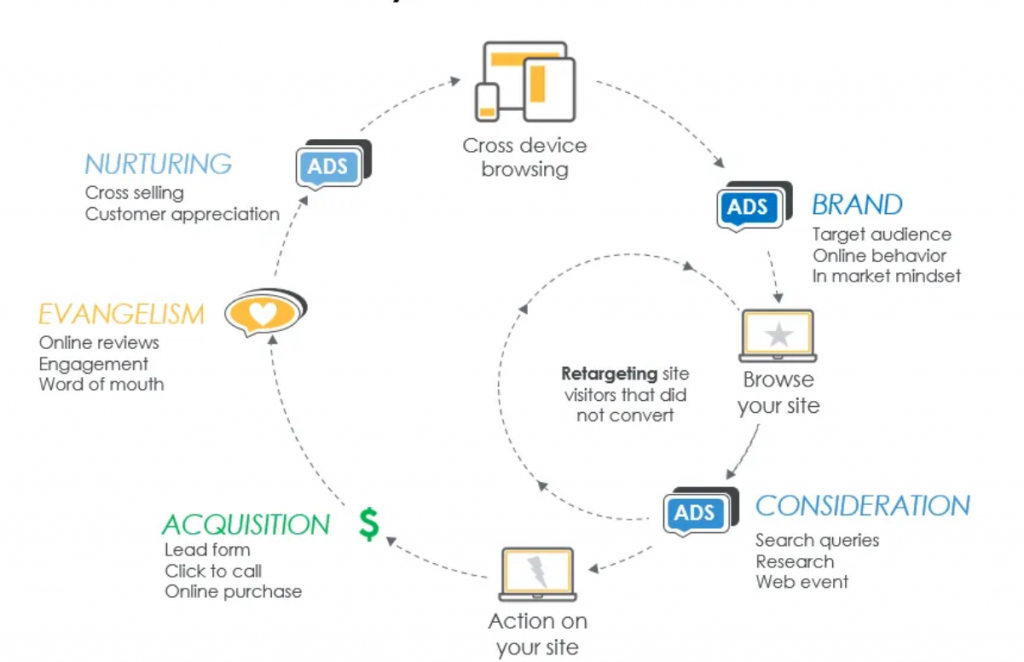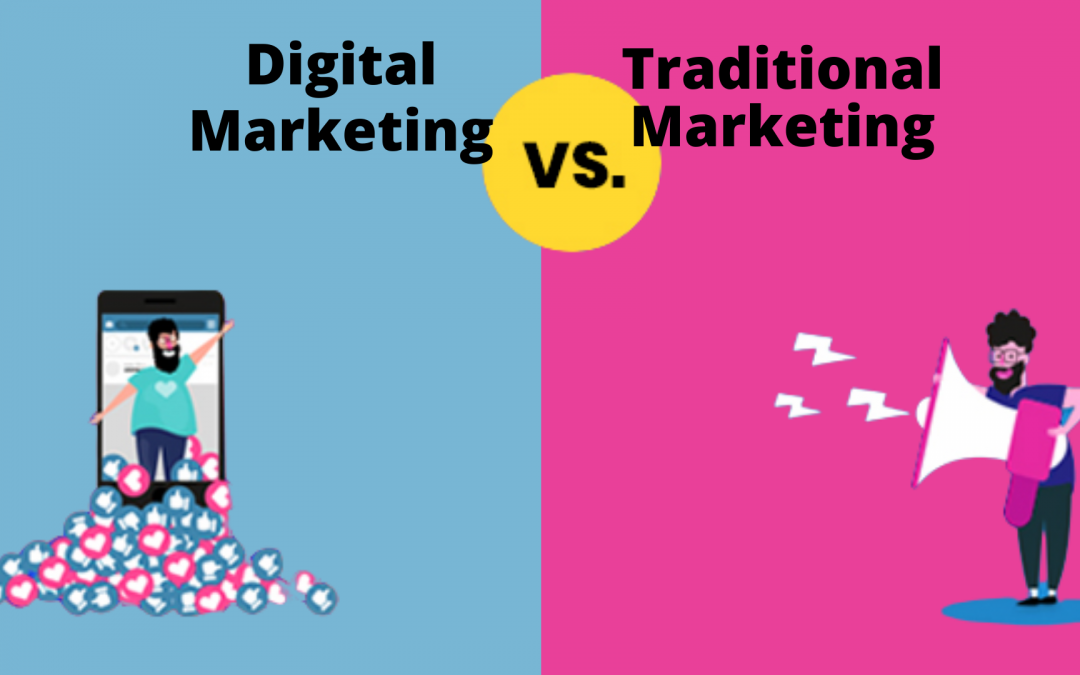Marketing is an essential component of any business. It is the process of promoting and selling products or services to customers. There are two main types of marketing: traditional marketing and digital marketing. In this article, we will explore the differences between these two approaches and the benefits and drawbacks of each.
Traditional Marketing
Traditional marketing is the conventional form of marketing that involves offline activities such as print advertisements, billboards, radio and TV commercials, brochures, flyers, and telemarketing. This form of marketing has been around for centuries and has a proven track record of success.

How does Traditional Marketing work?
Traditional marketing refers to any form of marketing that does not involve the use of digital channels. Here’s a general overview of how traditional marketing works:
- Define your target audience: Like digital marketing, traditional marketing also requires a clear understanding of your target audience. You need to identify who your ideal customer is, what their needs are, and how they are likely to respond to different marketing messages.
- Develop a marketing strategy: Once you have identified your target audience, you can create a traditional marketing strategy that will reach and engage them. This can include advertising in newspapers, magazines, radio, television, billboards, and direct mail campaigns.
- Create your marketing materials: Traditional marketing typically involves the creation of physical marketing materials, such as print ads, flyers, brochures, and billboards. You need to develop high-quality, eye-catching designs that will grab the attention of your target audience.
- Place your ads: Once you have created your marketing materials, you need to place them in the right locations to reach your target audience. This can involve purchasing ad space in magazines or newspapers, booking radio or television airtime, or placing billboards in high-traffic areas.
- Monitor and analyze your results: As with digital marketing, traditional marketing requires ongoing monitoring and analysis to determine the effectiveness of your campaigns. You need to track your results, measure your ROI, and adjust your strategy as needed to maximize your marketing efforts.
Advantages of Traditional Marketing
- Wider Audience Reach: Traditional marketing can reach a broader audience as it involves physical advertising such as billboards, print advertisements, and TV commercials. This type of advertising can reach people who do not have access to the Internet.
- Tangible: Traditional marketing provides physical ads that customers can touch, feel, and experience. This creates a sense of tangibility and establishes trust and credibility.
- Familiarity: Traditional marketing has been around for a long time and is familiar to many customers. This familiarity creates a sense of reliability and trustworthiness.
Disadvantages of Traditional Marketing
- Limited Metrics: Traditional marketing does not offer detailed metrics, such as conversion rates, click-through rates, and engagement rates, which makes it difficult to measure the effectiveness of the campaign.
- Expensive: Traditional marketing can be expensive as it involves printing, distribution, and media placement costs. The cost of production and distribution can be prohibitive for small businesses.
- Limited Targeting: Traditional marketing is not as targeted as digital marketing. Ads are often placed in locations where they will be seen by a large number of people, but not necessarily by the target audience.
Digital Marketing
Digital marketing is a form of marketing that involves online activities such as social media marketing, search engine optimization, email marketing, pay-per-click advertising, and mobile marketing. This type of marketing has gained significant traction over the years due to the increasing use of the internet and digital devices.
How does Digital Marketing work?
Digital marketing is the use of digital channels, such as search engines, social media, email, mobile apps, and websites to promote products or services to target audiences. Here’s a general overview of how digital marketing works:

- Define your target audience: The first step in any marketing campaign is to define your target audience. You need to understand who your ideal customer is, what their needs are, and where they spend their time online.
- Develop a marketing strategy: Once you have identified your target audience, you can create a digital marketing strategy that will reach and engage them. Your strategy should include the channels you will use, the content you will create, and the goals you want to achieve.
- Create content: Content is the cornerstone of any digital marketing campaign. You need to create high-quality content that resonates with your audience and provides value. This can include blog posts, videos, infographics, social media posts, and more.
- Promote your content: Once you have created your content, you need to promote it across your chosen channels. This can include paid advertising, social media marketing, email marketing, and search engine optimization.
- Monitor and analyze your results: Digital marketing is an ongoing process, and you need to constantly monitor and analyze your results. This will help you identify what is working and what needs to be improved, so you can refine your strategy and get better results over time.
Advantages of Digital Marketing
- Detailed Metrics: Digital marketing provides detailed metrics such as conversion rates, click-through rates, and engagement rates. This makes it easier to measure the effectiveness of the campaign and make necessary adjustments.
- Targeted Marketing: Digital marketing allows businesses to target specific demographics, interests, and behaviors. This ensures that the ads are seen by the right people, leading to better conversion rates.
- Cost-Effective: Digital marketing can be more cost-effective than traditional marketing. With a lower cost of entry, small businesses can compete with larger businesses.
Disadvantages of Digital Marketing
- Constant Change: Digital marketing is constantly changing. New technologies and platforms are introduced, and businesses need to keep up to date with the latest trends.
- Cybersecurity Risks: Digital marketing involves the collection of personal data, which increases the risk of cybersecurity breaches. Businesses need to be vigilant in protecting their customers’ data.
- Saturation: The internet is saturated with ads, and customers can quickly become overwhelmed. Ads need to be well-crafted and targeted to stand out from the competition.
Conclusion
In conclusion, both traditional marketing and digital marketing have their advantages and disadvantages. Traditional marketing provides a wider audience reach and tangible ads, while digital marketing offers detailed metrics and targeted marketing. Businesses need to consider their goals, budget, and target audience when deciding which form of marketing to use. In today’s digital world, digital marketing is becoming more prevalent, but traditional marketing still has a place in the marketing mix. A combination of both traditional and digital marketing can provide a well-rounded approach to marketing.

